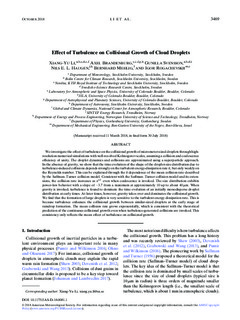Effect of Turbulence on Collisional Growth of Cloud Droplets
Li, Xiangyu; Brandenburg, Axel; Svensson, Gunilla; Haugen, Nils Erland L; Mehlig, Bernhard; Rogachevskii, Igor
Journal article, Peer reviewed
Published version

Åpne
Permanent lenke
http://hdl.handle.net/11250/2590983Utgivelsesdato
2018Metadata
Vis full innførselSamlinger
Originalversjon
Journal of the Atmospheric Sciences. 2018, 75 (10), 3469-3487. 10.1175/JAS-D-18-0081.1Sammendrag
Weinvestigate the effect of turbulence on the collisional growth of micrometer-sized droplets through highresolution numerical simulations with well-resolved Kolmogorov scales, assuming a collision and coalescence efficiency of unity. The droplet dynamics and collisions are approximated using a superparticle approach. In the absence of gravity, we show that the time evolution of the shape of the droplet-size distribution due to turbulence-induced collisions depends strongly on the turbulent energy-dissipation rate ε, but only weakly on the Reynolds number. This can be explained through the « dependence of the mean collision rate described by the Saffman-Turner collision model. Consistent with the Saffman-Turner collision model and its extensions, the collision rate increases as ε1/2 even when coalescence is invoked. The size distribution exhibits power-law behavior with a slope of 23.7 from a maximum at approximately 10 up to about 40 mm. When gravity is invoked, turbulence is found to dominate the time evolution of an initially monodisperse droplet distribution at early times. At later times, however, gravity takes over and dominates the collisional growth. We find that the formation of large droplets is very sensitive to the turbulent energy dissipation rate. This is because turbulence enhances the collisional growth between similar-sized droplets at the early stage of raindrop formation. The mean collision rate grows exponentially, which is consistent with the theoretical prediction of the continuous collisional growth even when turbulence-generated collisions are invoked. This consistency only reflects the mean effect of turbulence on collisional growth. © 2018 American Meteorological Society.